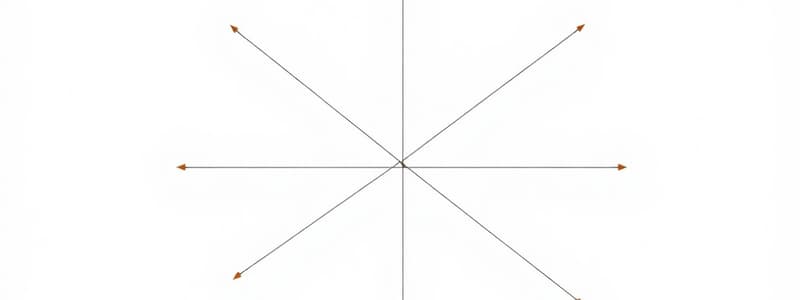Podcast
Questions and Answers
What type of angles are formed when a transversal intersects two parallel lines and are located outside the lines on the same side of the transversal?
What type of angles are formed when a transversal intersects two parallel lines and are located outside the lines on the same side of the transversal?
- Alternate interior angles
- Consecutive exterior angles (correct)
- Vertical angles
- Linear pair
Which statement correctly describes complementary angles?
Which statement correctly describes complementary angles?
- Their measures add up to 180 degrees.
- Their measures add up to 90 degrees. (correct)
- They are adjacent angles next to each other.
- They are formed by a transversal cutting through two parallel lines.
What is the Triangle Sum Theorem?
What is the Triangle Sum Theorem?
- The sum of the lengths of any two sides of a triangle is greater than the length of the third side.
- Two angles are supplementary if they add to 90 degrees.
- The sum of the interior angles of a triangle is equal to 180 degrees. (correct)
- In an isosceles triangle, the two base angles are congruent.
What type of triangle has all sides of different lengths?
What type of triangle has all sides of different lengths?
Which property states that a geometric figure is always equal to itself?
Which property states that a geometric figure is always equal to itself?
What are angles called that are across from each other when two lines intersect?
What are angles called that are across from each other when two lines intersect?
What is the longest side of a right triangle called?
What is the longest side of a right triangle called?
Which angles are located on opposite sides of the transversal but inside two lines cut by the transversal?
Which angles are located on opposite sides of the transversal but inside two lines cut by the transversal?
Flashcards
Transversal
Transversal
A line that cuts across two other lines in the same plane.
Vertical Angles
Vertical Angles
Angles opposite each other when two lines cross.
Linear Pair
Linear Pair
Two angles next to each other that add up to 180 degrees (a straight line).
Congruent Triangles
Congruent Triangles
Signup and view all the flashcards
Isosceles Triangle
Isosceles Triangle
Signup and view all the flashcards
Triangle Sum Theorem
Triangle Sum Theorem
Signup and view all the flashcards
Exterior Angle Sum Theorem
Exterior Angle Sum Theorem
Signup and view all the flashcards
Hypotenuse
Hypotenuse
Signup and view all the flashcards
Study Notes
Definitions
- Transversal: A line that passes through two other lines in the same plane.
- Vertical angles: Angles opposite each other when two lines cross.
- Linear pair: Two angles that are next to each other and form a straight line.
- Supplementary angles: Two angles that add up to 180 degrees.
- Complementary angles: Two angles that add up to 90 degrees.
- Alternate interior angles: Angles formed on opposite sides of a transversal and inside the two lines it intersects.
- Alternate exterior angles: A pair of angles that lie on the outside of two lines cut by a transversal, but on opposite sides of the transversal.
- Corresponding angles: Angles that are in the same position on different intersected lines.
- Consecutive exterior angles: A pair of angles formed when a transversal intersects two parallel lines, where both lie outside the parallel lines and on the same side of the transversal.
- Consecutive interior angles: A pair of angles formed when a transversal intersects two parallel lines, located on the same side of the transversal and inside the parallel lines.
Triangle Properties
- Congruent triangles: Triangles where all three corresponding sides and angles are equal in measure.
- Isosceles triangle: A triangle with at least two equal sides and angles.
- Equilateral triangle: A triangle with all three sides and angles equal in length.
- Scalene triangle: A triangle where all three sides and angles have different lengths.
- Triangle Sum Theorem: The sum of the interior angles of any triangle is 180 degrees.
- Exterior Angle Sum Theorem: The exterior angle of a triangle is equal to the sum of the two non-adjacent interior angles.
- Vertex angle: The angle formed by two rays or lines that meet at a common point.
- Base angle: The angles formed at the base of a triangle.
- Hypotenuse: The longest side of a right-angled triangle, opposite the right angle.
- Reflexive Property: A geometric figure is congruent to itself.
Studying That Suits You
Use AI to generate personalized quizzes and flashcards to suit your learning preferences.




